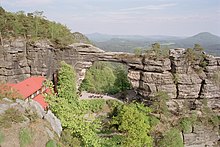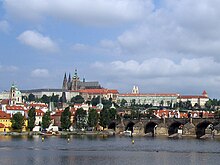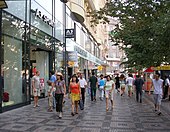The Czech Republic, short structure Česko Czech elocution, is a landlocked nation in Central Europe. The nation is outskirted by Germany to the west, Austria to the south, Slovakia to the east and Poland to the north. Its capital and greatest city, with 1.3 million tenants, is Prague. The Czech Republic incorporates the chronicled regions of Bohemia and Moravia and a little part of Silesia.
The Czech state, once in the past regarded as Bohemia, was shaped in the late 9th century as a modest duchy around Prague, around then under the strength of the compelling Great Moravian Empire. After the fall of the Empire in 907, the middle of force was exchanged from Moravia to Bohemia, under the Přemyslids. Since 1002 it was formally distinguished as a major aspect of the Holy Roman Empire. In 1212 the duchy was raised to a kingdom and throughout the principle of Přemyslid dukes/kings and their successors, the Luxembourgs, the nation arrived at its most amazing regional degree (13th–14th century). Throughout the Hussite wars the kingdom confronted investment embargoes and campaigns from from everywhere. Taking after the Battle of Mohács in 1526, the Kingdom of Bohemia was steadily mixed into the Habsburg government as one of its three chief parts, close by the Archduchy of Austria and the Kingdom of Hungary. The Bohemian Revolt (1618–20) lost in the Battle of White Mountain, expedited the further centralization of the government incorporating constrained recatholization and Germanization. With the disintegration of the Holy Roman Empire in 1806, the Bohemian kingdom ended up being part of the Austrian Empire. In the 19th century the Czech terrains came to be the streamlined powerhouse of the government and the center of the Republic of Czechoslovakia which was framed in 1918, emulating the cave in of the Austro-Hungarian Empire after World War I. After 1933, Czechoslovakia remained the main popular government in centermost and eastern Europe.
After the Munich Agreement, Polish addition of Zaolzie and German occupation of Czechoslovakia and the resulting baffle with the Western reaction and thankfulness for the liberation of the major bit of Czechoslovakia by the Red Army, the Communist Party of Czechoslovakia won the greater part in the 1946 decisions. In the 1948 rebellion, Czechoslovakia ended up being a comrade-led state. In 1968, the expanding disappointment built up and finally finished in endeavors to change the socialist administration. The occasions, reputed to be the Prague Spring of 1968, finished with an intrusion by the guards of the Warsaw Pact nations (with the special case of Romania); the troops stayed in the nation until the 1989 Velvet Revolution, when the socialist administration fallen. On 1 January 1993, Czechoslovakia calmly disintegrated into its constituent states, the Czech Republic and the Slovak Republic.
The Czech Republic is the first past part of the Comecon to realize the status of an advanced nation as per the World Bank. likewise, the nation has the most noteworthy human advancement in Central and Eastern Europe, standing as a "Very High Human Development" country. It is additionally stacked up as the third overwhelmingly serene nation in Europe and by and large vote based and solid (by baby mortality) nation in the locale. It is a pluralist multi-party parliamentary delegate majority rule government, a part of the European Union, NATO, the OECD, the OSCE, the Council of Europe and the Visegrád Group.
The Czech state, once in the past regarded as Bohemia, was shaped in the late 9th century as a modest duchy around Prague, around then under the strength of the compelling Great Moravian Empire. After the fall of the Empire in 907, the middle of force was exchanged from Moravia to Bohemia, under the Přemyslids. Since 1002 it was formally distinguished as a major aspect of the Holy Roman Empire. In 1212 the duchy was raised to a kingdom and throughout the principle of Přemyslid dukes/kings and their successors, the Luxembourgs, the nation arrived at its most amazing regional degree (13th–14th century). Throughout the Hussite wars the kingdom confronted investment embargoes and campaigns from from everywhere. Taking after the Battle of Mohács in 1526, the Kingdom of Bohemia was steadily mixed into the Habsburg government as one of its three chief parts, close by the Archduchy of Austria and the Kingdom of Hungary. The Bohemian Revolt (1618–20) lost in the Battle of White Mountain, expedited the further centralization of the government incorporating constrained recatholization and Germanization. With the disintegration of the Holy Roman Empire in 1806, the Bohemian kingdom ended up being part of the Austrian Empire. In the 19th century the Czech terrains came to be the streamlined powerhouse of the government and the center of the Republic of Czechoslovakia which was framed in 1918, emulating the cave in of the Austro-Hungarian Empire after World War I. After 1933, Czechoslovakia remained the main popular government in centermost and eastern Europe.
After the Munich Agreement, Polish addition of Zaolzie and German occupation of Czechoslovakia and the resulting baffle with the Western reaction and thankfulness for the liberation of the major bit of Czechoslovakia by the Red Army, the Communist Party of Czechoslovakia won the greater part in the 1946 decisions. In the 1948 rebellion, Czechoslovakia ended up being a comrade-led state. In 1968, the expanding disappointment built up and finally finished in endeavors to change the socialist administration. The occasions, reputed to be the Prague Spring of 1968, finished with an intrusion by the guards of the Warsaw Pact nations (with the special case of Romania); the troops stayed in the nation until the 1989 Velvet Revolution, when the socialist administration fallen. On 1 January 1993, Czechoslovakia calmly disintegrated into its constituent states, the Czech Republic and the Slovak Republic.
The Czech Republic is the first past part of the Comecon to realize the status of an advanced nation as per the World Bank. likewise, the nation has the most noteworthy human advancement in Central and Eastern Europe, standing as a "Very High Human Development" country. It is additionally stacked up as the third overwhelmingly serene nation in Europe and by and large vote based and solid (by baby mortality) nation in the locale. It is a pluralist multi-party parliamentary delegate majority rule government, a part of the European Union, NATO, the OECD, the OSCE, the Council of Europe and the Visegrád Group.
Geography
The Czech Republic falsehoods generally between scopes 48° and 51° N (a humble range lies north of 51°), and longitudes 12° and 19° E. The Czech view is exceedingly fluctuated. Bohemia, to the west, comprises of a bowl emptied by the Elbe (Czech: Labe) and the Vltava (or Moldau) waterways, encompassed by chiefly flat mountains, for example the Krkonoše extent of the Sudetes. The most elevated focus in the nation, Sněžka at 1,602 m (5,256 ft), is spotted here. Moravia, the eastern part of the nation, is additionally uneven. It is emptied primarily by the Morava River, yet it moreover holds the source of the Oder River (Czech: Odra).
Water from the landlocked Czech Republic streams to three diverse oceans: the North Sea, Baltic Sea and Black Sea. The Czech Republic likewise rents the Moldauhafen, a 30,000-square-metre (7.4-plot of land equal to 4840 square yards) part amidst the Hamburg Docks, which was granted to Czechoslovakia by Article 363 of the Treaty of Versailles, to permit the landlocked nation a spot where merchandise transported down waterway might be exchanged to seagoing ships. The region returns to Germany in 2028.
Phytogeographically, the Czech Republic fits in with the Central European region of the Circumboreal Region, inside the Boreal Kingdom. Consistent with the World Wide Fund for Nature, the region of the Czech Republic could be subdivided into four ecoregions: the Central European jumbled woodlands, Pannonian intermingled woods, Western European broadleaf woodlands and Carpathian montane conifer backwoods.
There are four national stops in the Czech Republic. The most seasoned is Krkonoše National Park (Biosphere Reserve), Šumava National Park (Biosphere Reserve), Podyjí National Park, Bohemian Switzerland.
Water from the landlocked Czech Republic streams to three diverse oceans: the North Sea, Baltic Sea and Black Sea. The Czech Republic likewise rents the Moldauhafen, a 30,000-square-metre (7.4-plot of land equal to 4840 square yards) part amidst the Hamburg Docks, which was granted to Czechoslovakia by Article 363 of the Treaty of Versailles, to permit the landlocked nation a spot where merchandise transported down waterway might be exchanged to seagoing ships. The region returns to Germany in 2028.
Phytogeographically, the Czech Republic fits in with the Central European region of the Circumboreal Region, inside the Boreal Kingdom. Consistent with the World Wide Fund for Nature, the region of the Czech Republic could be subdivided into four ecoregions: the Central European jumbled woodlands, Pannonian intermingled woods, Western European broadleaf woodlands and Carpathian montane conifer backwoods.
There are four national stops in the Czech Republic. The most seasoned is Krkonoše National Park (Biosphere Reserve), Šumava National Park (Biosphere Reserve), Podyjí National Park, Bohemian Switzerland.
Climate
The Czech Republic has a temperate mainland atmosphere, with comparatively sizzling summers and frosty, shady and frigid winters. The temperature contrast between summer and winter is moderately heightened, because of the landlocked land position.
Inside the Czech Republic, temperatures differ incredibly, relying on the rise. As a rule, at higher elevations, the temperatures reduction and precipitation increments. The wettest territory in the Czech Republic is recognized around Bílý Potok in Jizera Mountains and the driest district is the Louny District to the northwest of Prague. An additional imperative variable is the appropriation of the mountains; in this manner, the atmosphere is very changed.
Inside the Czech Republic, temperatures differ incredibly, relying on the rise. As a rule, at higher elevations, the temperatures reduction and precipitation increments. The wettest territory in the Czech Republic is recognized around Bílý Potok in Jizera Mountains and the driest district is the Louny District to the northwest of Prague. An additional imperative variable is the appropriation of the mountains; in this manner, the atmosphere is very changed.
At the most elevated crest of Sněžka (1,602 m/5,256 ft), the normal temperature is just −0.4 °C (31 °F), though in the marshes of the South Moravian Region, the normal temperature is as towering as 10 °C (50 °F). The nation's capital, Prague, has a comparable normal temperature, even though this is affected by urban calculates.
The coldest month is typically January, emulated by February and December. Throughout the aforementioned months, there is ordinarily snow in the mountains and at times in the major urban communities and marshes. Throughout March, April and May, the temperature generally builds quickly, specifically throughout April, when the temperature and climate for the most part differ considerably throughout the day. Spring is additionally portrayed by elevated water levels in the streams, because of softening snow with intermittent flooding.
The warmest month of the year is July, accompanied by August and June. On normal, summer temperatures are around 20 °C higher than throughout winter. Temperatures above 30 °C (86 °F) are not irregular. Summer is additionally described by drizzle and storms.
Harvest time for the most part starts in September, which is still proportionally warm and dry. Throughout October, temperatures normally fall beneath 15 °C (59 °F) or 10 °C (50 °F) and deciduous trees start to shed their takes off. Toward the conclusion of November, temperatures for the most part extend around the solidifying focus.
The coldest temperature ever measured was in Litvínovice close České Budějovice in 1929, at −42.2 °C (−44.0 °F) and the most sizzling measured, was at 40.4 °C (104.7 °F) in Dobřichovice in 2012.
Most rain falls throughout the middle of the year. Sporadic precipitation is proportionally reliable all through the year (in Prague, the normal number of days for every month encountering in any event 0.1 mm of downpour differs from 12 in September and October to 16 in November) yet thought large precipitation (days with more than 10 mm for every day) are more regular in the months of May to August (normal around two such days for every month).
Tourism
The Czech economy gets a generous wages from tourism. In 2011, Prague was the sixth overwhelmingly went to city in Europe. In 2001, the aggregate profit from tourism arrived at 118.13 billion CZK, making up 5.5% of GNP and 9.3% of generally speaking fare wages. The industry utilizes more than 110,000 individuals – over 1% of the population. In 2008, be that as it may, there was a droop in traveler numbers in Prague, perhaps because of the solid Czech koruna (crown) making the nation excessively unreasonable for guests, contrasted with the level of utilities that were available.
The nation's notoriety has additionally endured with manuals and travelers reporting cheating by taxi drivers and pickpocketing problems. Since 2005, Prague's leader, Pavel Bém, has worked to enhance this notoriety by getting serious about unimportant crime and, aside from the aforementioned situations, Prague is a protected city. Also, the Czech Republic as an entire usually has a level wrongdoing rate. For voyagers, the Czech Republic is acknowledged a protected end to visit. The flat wrongdoing rate makes most urban areas and towns sheltered to stroll around even after dull.
There are a few centres of traveler movement. The spa towns, for example Karlovy Vary, Mariánské Lázně and Františkovy Lázně, are absolutely ubiquitous occasion destinations. Other in vogue traveler locales are the numerous palaces and chateaux, for example those at Karlštejn Castle, Český Krumlov and the Lednice–Valtice zone. There are 15 chapels raised to the rank of basilica by the Pope. Far from the towns, regions for example Český ráj, Šumava and the Krkonoše Mountains lure guests looking for open air hunts.
The nation is moreover well known for its adore of puppetry and dolls with various manikin celebrations all through the country.
The Czech Republic moreover has various brew celebrations, incorporating: Czech Beer Festival (the greatest Czech brew celebration, it is 17 days in length and held each year in May in Prague), Pilsner Fest (each year in August in Plzeň), The "Olomoucký pivní celebration" (in Olomouc) or celebration "Slavnosti piva v Českých Budějovicích" (in České Budějovice).
Demographics
Consistent with preparatory comes about of the 2011 enumeration, the lion's share of the occupants of the Czech Republic are Czechs (63.7%), accompanied by Moravians (4.9%), Slovaks (1.4%), Poles (0.4%), Germans (0.2%) and Silesians (0.1%). As the 'nationality' was a nonobligatory thing, a significant number of individuals left this field clear (26.0%). According to certain assesses, there are around 250,000 Romani individuals in the Czech Republic.
There were 436,116 nonnatives dwelling in the nation in October 2009, consistent with the Czech Interior Ministry, with the greatest assemblies being Ukrainian (132,481), Slovak (75,210), Vietnamese (61,102), Russian (29,976), Polish (19,790), German (14,156), Moldovan (10,315), Bulgarian (6,346), Mongolian (5,924), American (5,803), Chinese (5,314), British (4,461), Belarusian (4,441), Serbian (4,098), Romanian (4,021), Kazakh (3,896), Austrian (3,114), Italian (2,580), Dutch (2,553), French (2,356), Croatian (2,351), Bosnian (2,240), Armenian (2,021), Uzbek (1,969), Macedonian (1,787) and Japanese (1,581).
The Jewish inhabitant total of Bohemia and Moravia, 118,000 consistent with the 1930 enumeration, was basically destroyed by the Nazi Germans throughout the Holocaust. There were roughly 4,000 Jews in the Czech Republic in 2005. The preceding Czech leader, Jan Fischer, is of Jewish source and faith.
Assessments of Czech richness rate in 2012 are around the least in the planet at 1.27 kids for every woman. Immigration expanded the inhabitants present by practically 1% in 2007. Around 77,000 new outsiders settle down in the Czech Republic each year. Vietnamese foreigners started settling in the Czech Republic throughout the Communist period, when they were welcomed as visitor laborers by the Czechoslovak government. In 2009, there were around 70,000 Vietnamese in the Czech Republic. rather than Ukrainians, Vietnamese go to the Czech Republic to exist permanently.
At the turn of the 20th century, Chicago was the city with the third greatest Czech population, after Prague and Vienna. According to the 2006 US registration, there are 1,637,218 Americans of full or halfway Czech descent.
Religion
The Czech Republic has one of the slightest religious inhabitant totals in the planet. Generally, the Czech individuals have been characterised as "tolerant and even impassive towards religion". According to the 2011 evaluation, 34.2% of the inhabitants present stated they had no religion, 10.3% was Roman Catholic, 0.8% was Protestant (0.5% Czech Brethren and 0.4% Hussite), and 9.4% emulated different manifestations of religion both denominational or not (of which 863 individuals addressed they are Pagan) 45.2% of the people did not address the concern about religion. From 1991 to 2001 and further to 2011 the adherence to Roman Catholicism diminished from 39.0 to 26.8 then after that to 10.3; Protestantism comparably declined from 3.7% to 2.1% and after that to 0.8%.
As per an Eurobarometer Poll in 2010, 16% of Czech subjects reacted that "they accept there is a God" (the most minimal rate right around the nations of the European Union), while 44% addressed that "they accept there is some sort of spirit or essence power" and 37% stated that "they don't accept there is any sort of spirit, God or essence power".
As per an Eurobarometer Poll in 2010, 16% of Czech subjects reacted that "they accept there is a God" (the most minimal rate right around the nations of the European Union), while 44% addressed that "they accept there is some sort of spirit or essence power" and 37% stated that "they don't accept there is any sort of spirit, God or essence power".
Miss Czech Republic 2012:
![Location of Czech Republic (dark green)– in Europe (green & dark grey)– in the European Union (green) — [Legend]](http://upload.wikimedia.org/wikipedia/commons/thumb/3/33/EU-Czechia.svg/250px-EU-Czechia.svg.png)















No comments:
Post a Comment